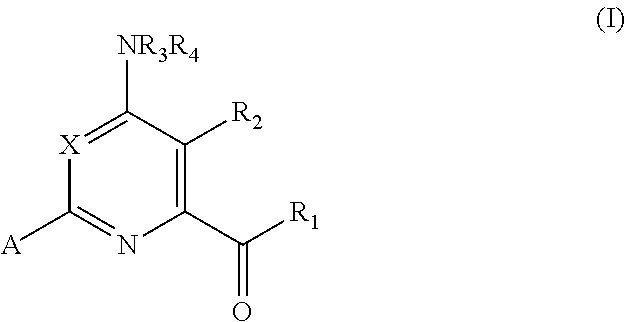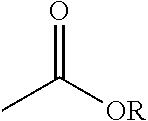4-amino-6-(heterocyclic)picolinates and 6-amino-2-(heterocyclic)pyrimidine-4-carboxylates and their use as herbicides
a technology of pyrimidine and pyrimidine, which is applied in the field of herbicides and compositions, can solve the problems of undesirable vegetation occurrence and negatively affecting crop yield
- Summary
- Abstract
- Description
- Claims
- Application Information
AI Technical Summary
Benefits of technology
Problems solved by technology
Method used
Image
Examples
example 1
Methyl 4-amino-6-(benzo[c][1,2,5]oxadiazol-5-yl)-3-chloro-5-fluoropicolinate
[0180]
[0181]Bis(triphenylphosphine)palladium(II) chloride (110 mg, 0.16 mmol) and sodium carbonate (210 mg, 2.0 mmol) were sequentially added to a stirred mixture of ˜60% 5-(4,4,5,5-tetramethyl-1,3,2-dioxaborolan-2-yl)benzo[c][1,2,5]oxadiazole (900 mg, 2.2 mmol) and methyl 4-amino-3,6-dichloro-5-fluoropicolinate (480 mg, 2.0 mmol, 1.0 equiv) in a 1:1 mixture of water:acetonitrile (6.8 mL) at 23° C. The resulting brown mixture was heated to 85° C. and stirred for 4 h. The cooled reaction mixture was diluted with water (150 mL) and extracted with dichloromethane (3×80 mL). The combined organic layers were dried (magnesium sulfate), gravity filtered, and concentrated by rotary evaporation. The residue was purified by reverse phase column chromatography (5% acetonitrile to 100% acetonitrile gradient) to afford the title compound as a tan powder (370 mg, 57% yield).
[0182]The preparation method used in this exampl...
example 2
Methyl 6-amino-2-(6-fluorobenzo[c][1,2,5]oxadiazol-5-yl)-5-methoxypyrimidine-4-carboxylate
[0183]
[0184]Methyl 6-amino-2-chloro-5-methoxypyrimidine-4-carboxylate (400 mg, 1.838 mmol), 5-fluoro-6-(4,4,5,5-tetramethyl-1,3,2-dioxaborolan-2-yl)benzo[c][1,2,5]oxadiazole (789 mg, 2.390 mmol), bis(triphenylphosphine)palladium(II) chloride (129 mg, 0.184 mmol), and cesium fluoride (558 mg, 3.68 mmol) were combined in 4 mL 1:1 ACN-water and heated at 115° C. for 30 min in a microwave reactor. The cooled reaction mixture was partitioned between ethyl acetate and water. The organic phase was washed with saturated NaCl, dried, and evaporated. The product was purified by flash chromatography (SiO2, eluting with 5-30% ethyl acetate in dichloromethane) to provide the title compound (240 mg, 39%).
[0185]The preparation method used in this example is referred to in Table 2 as “Coupling 2.”
example 3
Methyl 4-amino-3-chloro-6-(6-fluorobenzo[c][1,2,5]oxadiazol-5-yl)picolinate (Compound 4)
[0186]
[0187]5-bromo-6-fluorobenzo[c][1,2,5]oxadiazole (300 mg, 1.383 mmol) was dissolved in 7 ml dry DMF and the solution was sparged with a stream of nitrogen for 10 min. Bis(triphenylphosphine)palladium(II) chloride (97 mg, 0.138 mmol), copper(I) iodide (26.3 mg, 0.138 mmol) and methyl 4-acetamido-3-chloro-6-(trimethylstannyl)picolinate (541 mg, 1.383 mmol) were added and the mix was heated at 70° C. for 3 h. The reaction mixture was cooled and partitioned between ethyl acetate and water. The organic phase was washed with saturated NaCl, dried, and evaporated. The residue was purified by flash chromatography (SiO2, eluting with 0-30% ethyl acetate in dichloromethane) to provide the intermediate amide as a white solid (220 mg, 44%): 1H NMR (400 MHz, CDCl3) δ 9.05 (d, J=2.3 Hz, 1H), 8.43 (dd, J=6.8, 0.6 Hz, 1H), 8.04 (s, 1H), 7.56 (dd, J=9.7, 0.6 Hz, 1H), 4.05 (s, 3H), 2.36 (s, 3H). 19F NMR (376 ...
PUM
| Property | Measurement | Unit |
|---|---|---|
| storage stability | aaaaa | aaaaa |
| pH | aaaaa | aaaaa |
Abstract
Description
Claims
Application Information
 Login to View More
Login to View More - R&D
- Intellectual Property
- Life Sciences
- Materials
- Tech Scout
- Unparalleled Data Quality
- Higher Quality Content
- 60% Fewer Hallucinations
Browse by: Latest US Patents, China's latest patents, Technical Efficacy Thesaurus, Application Domain, Technology Topic, Popular Technical Reports.
© 2025 PatSnap. All rights reserved.Legal|Privacy policy|Modern Slavery Act Transparency Statement|Sitemap|About US| Contact US: help@patsnap.com



